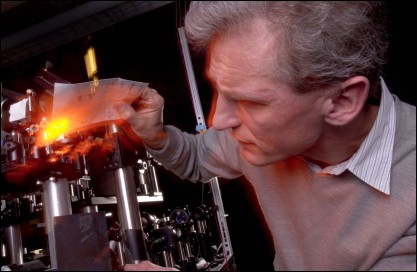In recent years physicists have realized that fermions can exhibit superfluid behaviour because of their ability to pair up at very low temperatures. Now a US group has shown that if a mixture of fermions is prepared with the majority in the same spin state, they can appear to pair up without behaving as a superfluid at all. This discovery might eventually enable a greater insight into high-temperature superconductivity, which also involves pairing but is often too complex to study directly (Science 316 867).

Particles fall into two categories: bosons, which have integer spin values, and fermions, which have half-integer spin values. When cooled close to absolute zero, bosons all fall into a single ground state, collectively undergoing a transition to a peculiar phase of matter called a Bose-Einstein condensate (BEC). While in a BEC, the bosons move as a coherent whole, exhibiting weird macroscopic quantum effects such as superfluidity.
Although quantum mechanics forbids any two fermions to occupy the same state, in certain conditions they can still condense into a BEC by pairing up under attractive forces and thus imitating integer-spin bosons. The pairing is strongest when spin states of the two fermions in a pair are different – electrons, for example, form “Cooper” pairs when they are in “up” and “down” spin states. Because electrons are charged, their superfluid flow also gives rise to superconductivity, an important property described by Bardeen Cooper Schrieffer theory.
However, the superfluid state becomes less prevalent in a system if the ratio of fermion spin-states is imbalanced. This discovery was made last year by a group at the Massachusetts Institute of Technology (MIT) in the US led by Wolfgang Ketterle, who used radio-frequency fields to transfer populations of spin states in an ultracold gas of neutral fermionic atoms – a much simpler system to study than superconductivity in electron gases. They found that at low enough temperatures the gas separated into two regions: the minority spin state paired-up in the core of the gas with an equal number of fermions from the majority spin state, thus behaving as a superfluid; and the remainder of the majority spin state was left to congregate around the outside.
Now the same MIT group has seen what happens if the ratio of fermion spin-states is heavily imbalanced. To do this, they prepared a mixture of lithium-6 atoms (fermions) with 95% in the same spin state, and then used radio-frequency spectroscopy to measure the excitation spectrum. This spectrum allowed them to search for atoms bound in pairs, which are highlighted by a characteristic high-frequency peak.
In such heavily-imbalanced mixtures, the so-called Chandrasekhar-Clogston limit is known to prevent a superfluid state from ever forming at low temperatures – and this was indeed observed by Ketterle and his colleagues. However, they found that the minority of spin states (5%) still bound together in pairs. “It always appeared that when pairs of fermions are formed they will ultimately condense at low temperature,” Ketterle told Physics Web. “Now we have a situation where they just form and never condense.”
Ketterle added that by studying the pairing of fermions that have not condensed to a superfluid at low temperatures, physicists may eventually be able to test theories of poorly-understood systems such as high-temperature superconductors, which exhibit pairing above the condensation temperature. However, he said that the discovery also raises the big question of how the fermions are pairing without becoming a superfluid: “One has to figure out what is meant by pairing. I cannot say whether it is a result of a ‘monogamous’ relationship, or if each atom is attracted by several other atoms in the other spin state.”



